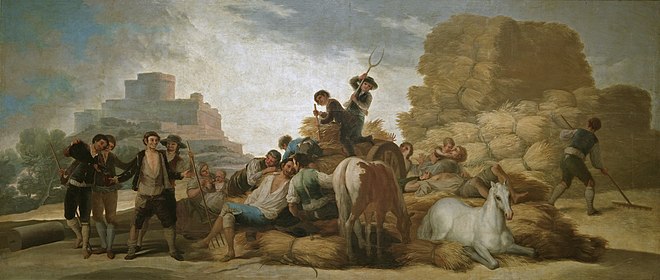
Francisco José de Goya y Lucientes was a Spanish romantic painter and printmaker. He is considered the most important Spanish artist of the late 18th and early 19th centuries. His paintings, drawings, and engravings reflected contemporary historical upheavals and influenced important 19th- and 20th-century painters. Goya is often referred to as the last of the Old Masters and the first of the moderns.

Spanish art has been an important contributor to Western art and Spain has produced many famous and influential artists including Velázquez, Goya and Picasso. Spanish art was particularly influenced by France and Italy during the Baroque and Neoclassical periods, but Spanish art has often had very distinctive characteristics, partly explained by the Moorish heritage in Spain, and through the political and cultural climate in Spain during the Counter-Reformation and the subsequent eclipse of Spanish power under the Bourbon dynasty.
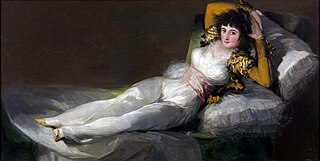
La maja vestida is an oil painting on canvas created between 1800 and 1807 by the Spanish Romantic painter and printmaker Francisco Goya. It is a clothed version of the earlier La maja desnuda, which was created between 1795 and 1800. The identity of the model and that of the commissioner have not been confirmed. However, art historians and scholars have suggested she is María Cayetana de Silva or Godoy's mistress Pepita Tudó. The Clothed Maja was created during the peak of Romanticism.

Tomás de Yepes or Hiepes was a Spanish painter in the Kingdom of Valencia. An artist of the Baroque movement, he worked as a painter of still life and bodegón—still life paintings depicting pantry items. He made paintings both for clients and public events. Although his activity started in the second decade of the 17th century, most of the works attributed to him come after 1642. He continued to paint until the year of his death.

The Sleep of Reason Produces Monsters or The Dream of Reason Produces Monsters is an aquatint by the Spanish painter and printmaker Francisco Goya. Created between 1797 and 1799 for the Diario de Madrid, it is the 43rd of the 80 aquatints making up the satirical Los caprichos.

The Colossus, is known in Spanish as El Coloso and also El Gigante, El Pánico and La Tormenta. It is a painting traditionally attributed to Francisco de Goya that shows a giant in the centre of the canvas walking towards the left hand side of the picture. Mountains obscure his legs up to his thighs and clouds surround his body; the giant appears to be adopting an aggressive posture as he is holding one of his fists up at shoulder height. A dark valley containing a crowd of people and herds of cattle fleeing in all directions occupies the lower third of the painting.
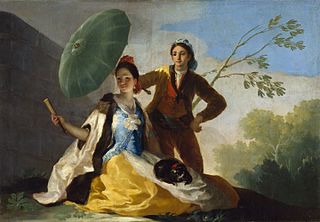
The Parasol is one of a cartoon series of oil on linen paintings made by the painter Francisco Goya. This series of paintings was specifically made in order to be transformed into tapestries that would be hung on the walls of the Royal Palace of El Pardo in Madrid, Spain. The tapestries showed serene events in everyday life, which made them a nice addition to the dining room of Prince and Princess of Asturias—the future King Charles IV and Maria Luisa of Parma. The queen called on Goya because she wanted to decorate the dining room with cheerful scenes; The Parasol and the other tapestry paintings were Goya's response to this request. The painting is currently located in the Museo del Prado in Madrid as is another in the series, Blind man's bluff.
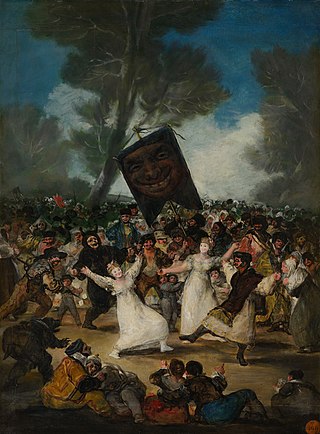
The Burial of the Sardine is an oil-on-panel painting by Spanish artist Francisco Goya, usually dated to the 1810s. The title is posthumous, referring to the culminating event, Entierro de la Sardina, of a three-day carnival in Madrid ending on Ash Wednesday. Masked and disguised revellers are seen dancing their way to the banks of the Manzanares, where a ceremonial sardine will be buried. Goya does not illustrate the fish in the painting, nor the large doll made of straw, called a pelele, from which it hung; the centrepiece is the darkly grinning "King of the Carnival".

A Pilgrimage to San Isidro is one of the Black Paintings painted by Francisco de Goya between 1819–23 on the interior walls of the house known as Quinta del Sordo that he purchased in 1819. It probably occupied a wall on the first floor of the house, opposite The Great He-Goat.

The Inquisition Tribunal, also known as The Court of the Inquisition or The Inquisition Scene, is a 46-by-73-centimetre oil-on-panel painting produced by the Spanish artist Francisco Goya between 1812 and 1819. The painting belongs to a series which also includes Bullfight, The Madhouse and A Procession of Flagellants, all reflecting customs which liberals objected to and wished were abandoned, but their reform was opposed by the absolutist (autocratic) policy of Ferdinand VII of Spain.

Christ Crucified is a 1780 oil-on-canvas painting of the crucifixion of Jesus by Spanish Romantic painter Francisco de Goya. He presented it to the Real Academia de Bellas Artes de San Fernando as his reception piece as an academic painter. It now forms part of the permanent collection of the Prado Museum in Madrid.
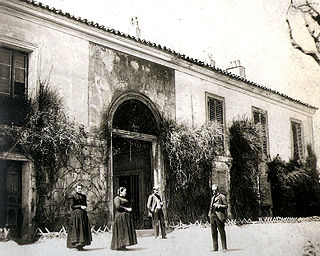
The Black Paintings is the name given to a group of 14 paintings by Francisco Goya from the later years of his life, likely between 1819 and 1823. They portray intense, haunting themes, reflective of both his fear of insanity and his bleak outlook on humanity. In 1819, at the age of 72, Goya moved into a two-story house outside Madrid that was called Quinta del Sordo. Although the house had been named after the previous owner, who was deaf, Goya too was nearly deaf at the time as a result of an unknown illness he had suffered when he was 46. The paintings originally were painted as murals on the walls of the house, later being "hacked off" the walls and attached to canvas by owner Baron Frédéric Émile d'Erlanger. They are now in the Museo del Prado in Madrid.

The Royal Tapestry Factory is a factory making tapestries in Madrid, Spain, which was founded in 1720 and is still in operation.
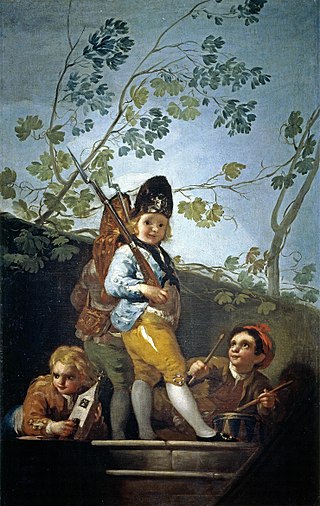
Boys playing soldiers is a 1778-79 tapestry cartoon by Francisco of Goya conceived for the bedroom of the Princes of Asturias in the Royal Palace of El Pardo. It is presently exhibited in the Museo del Prado. A sketch of the artwork is kept nowadays in the Yanduri Collection of Seville.

The Spanish royal collection of art was almost entirely built up by the monarchs of the Habsburg family who ruled Spain from 1516 to 1700, and then the Bourbons. They included a number of kings with a serious interest in the arts, who were patrons of a series of major artists: Charles V and Philip II were patrons of Titian, Philip IV appointed Velázquez as court painter, and Goya had a similar role at the court of Charles IV.

The Drunk Mason is an oil on canvas painted by Francisco de Goya, then reputed painter of tapestries for the royal palaces. It belonged to the fifth series undertaken by Goya, and, like all the pieces that compose it, was painted between 1786 and 1787.
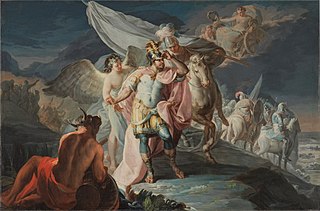
The Victorious Hannibal Seeing Italy from the Alps for the First Time, or Hannibal the victor crossing the Alps, or Hannibal the victorious from the heights of the Alps looks out over the plains of Italy is an oil painting by Spanish painter Francisco Goya, dating from his early years. It is the oldest documented work by the painter.

The tapestry cartoons of Francisco de Goya are a group of oil on canvas paintings by Francisco de Goya between 1775 and 1792 as designs for the Royal Tapestry Factory of Santa Barbara near Madrid in Spain. Although they are not the only tapestry cartoons made at the Royal Factory, they are much the best known. Most of them represent bucolic, hunting, rural and popular themes. They strictly adhered to the tastes of King Charles III and the princes Charles of Bourbon and Maria Luisa of Parma, and were supervised by other artists of the factory such as Maella and the Bayeu family. Most are now in the Museo del Prado, having remained in the Spanish Royal collection, although there are some in art galleries in other countries.

La novillada, is a painting by Francisco de Goya, painted in 1780, when he was trying his hand at bullfighting. It is part of the fourth series of tapestry cartoons for the Prince of Asturias' antechamber in the Pardo Palace.
